Dickinson's Real Deal
(c) Antique Metalware Society
Small extracts can be used with acknowledgements to 'Oldcopper.org' website.
Helpful comments are very welcome.

Exhibits supplied for agreed for the 'Insert Chat' at the ITV recording of 'Dickinson’s Real Deal', Ludlow, 23rd Feb 2013
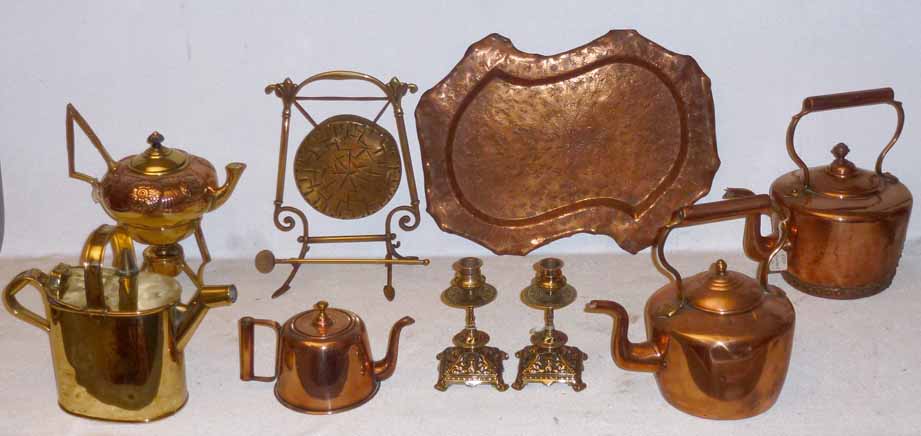
The researcher inviting me to the recording thought it a good idea to talk about the maker's marks of the best Birmingham factories so I took along photos of each mark to put with the items. David Dickinson took it much more simply during the chat and the marks were not seen. He just suggested that it is a good time to collect copper and brassware. The 'Ludlow 4' recording was first broadcast on the 13th December 2013 and repeated later.
1 Excellent Hot water can by John Marston, c1890
2 Plain Guernsey Jug by Henry Loveridge & Co, c1925
3 Typical Jug by Joseph Sankey & Sons with ‘Neptune’ mark c1920
4 Unusual ‘Burmese’ trademark on a gong by William Suckling & Co., c1897
5 Intriguing Townshend ‘Acanthus Gongs’ patterns, c1895
6 A puzzling Monogram by Matthew J Hart & Co., c1890
7 Quality Cast candlesticks from William Tonks & Sons, c1870
8 One of many Spirit Kettles by William Soutter & Sons c1910
9 Rare Victorian Kettle by William Soutter & Sons c1850-1890
10 Victorian Kettle with a History
11 ‘Kinco’ items made by British Metal (Kingston) Ltd
Career
Vin started work with copper in 1952 as a trainee laboratory assistant. Part time study for degree equivalent qualifications. Moved to Enfield Rolling Mills as Quality Assurance Manager in 1966. Moved to Copper Development Association in 1980 and retired in 1999 as Director. Over 100 technical papers and publications.
Introduction
To promote the identity of some Birmingham and Black Country makers of copper and brassware and highlight the only known website showing maker’s marks for copper and brass. To encourage prospective buyers of copper and brassware to inspect the items closely .
Vin Callcut retired after 50 years in the copper and brass industry and started a retirement project on domestic copper and brass. The first result is the website at ‘www.oldcopper.org’ now with about 350 makers’ marks shown together with some background on each maker. It gets about 50,000 page hits each month from enthusiasts world-wide. Naturally, many of the British makers are from Birmingham or the Black Country. Birmingham does not have an industrial art metalware museum covering the brassware for which it is famous.
1 Excellent Hot water can by John Marston, c1890
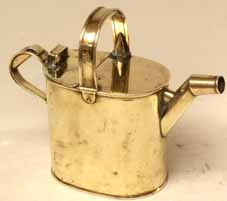
Hot water can by John Marston of Wolverhampton with quality features and ‘JM’ mark. The can is well made from best sheet brass with supporting fillets strengthening both handles and the spout. There is also a thumb catch near the lifting lid. All edges are properly seamed. The hot water can has already lasted over 100 years and is still fit for purpose.
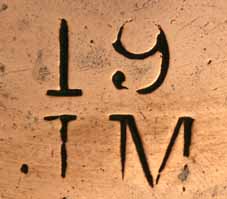
John Marston started as an apprentice to Richard Perry & Son then bought a japanning business in 1859 and started making good simple copperware. In 1902 he sold out to Orme Evans and went on to build ‘Sunbeam’ cycles and motorcycles.
2 Plain Guernsey Jug by Henry Loveridge & Co, c1925
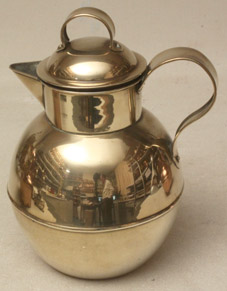 ‘Guernsey Jug by Henry Loveridge & Co of Wolverhampton, produced in quantity rather than by individual craftsmen in Guernsey. The maker’s monogram can be confusing. It is a monogram of ‘HL’ with the ‘L’ facing both ways. The reproduction milk jug can be compared with the hand made 1 ½ pint Guernsey jug with soldered seams.
‘Guernsey Jug by Henry Loveridge & Co of Wolverhampton, produced in quantity rather than by individual craftsmen in Guernsey. The maker’s monogram can be confusing. It is a monogram of ‘HL’ with the ‘L’ facing both ways. The reproduction milk jug can be compared with the hand made 1 ½ pint Guernsey jug with soldered seams.
 They were in business at the Merridale Works making domestic holloware from about 1886 until 1927.
They were in business at the Merridale Works making domestic holloware from about 1886 until 1927.
3 Typical Jug by Joseph Sankey & Sons with ‘Neptune’ mark c1920
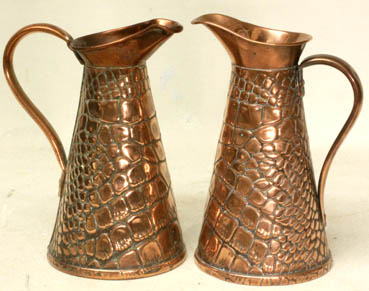 An elegant ‘Crocodile’ patterned jug by Joseph Sankey & Sons of Wolverhampton showing ‘Neptune’ mark that was used when shops did not want to market their stock under the usual ‘JS&S’ mark. To the rear is a similar jug with the usual ‘JS&S’ or JS&SB (with a ‘B’ added for Bilston) underneath.
An elegant ‘Crocodile’ patterned jug by Joseph Sankey & Sons of Wolverhampton showing ‘Neptune’ mark that was used when shops did not want to market their stock under the usual ‘JS&S’ mark. To the rear is a similar jug with the usual ‘JS&S’ or JS&SB (with a ‘B’ added for Bilston) underneath.
Sankey made jugs with patterns to suit many tastes.
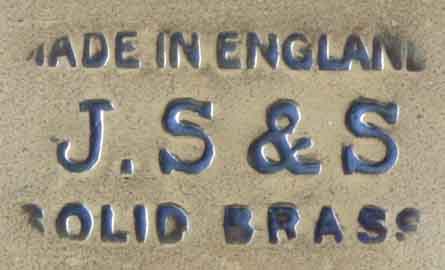
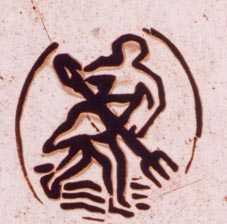 Sankey made art metalware in Bilston, Wolverhampton from about 1890, were at their best around 1910 and after the war continued until depression hit in 1922. Their name continues on other products.
Sankey made art metalware in Bilston, Wolverhampton from about 1890, were at their best around 1910 and after the war continued until depression hit in 1922. Their name continues on other products.
4 Unusual ‘Burmese’ trademark on a gong by William Suckling & Co., c1897
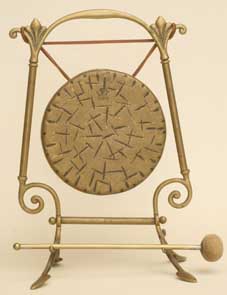 ‘Burmese’ symbol trademark on a gong with Registered Design No 281240 of 1896.
‘Burmese’ symbol trademark on a gong with Registered Design No 281240 of 1896.
A search at the National Archives in Kew showed that this design was registered by William Suckling & Co of Birmingham, gong-making specialists.
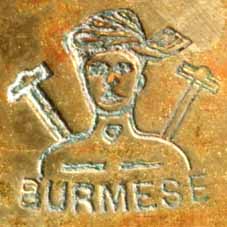 Their gongs are always well made, have a good tone and tend to be used in many of the better-quality designs and makes.
Their gongs are always well made, have a good tone and tend to be used in many of the better-quality designs and makes.
5 Intriguing Townshend ‘Acanthus Gongs’ patterns, c1895
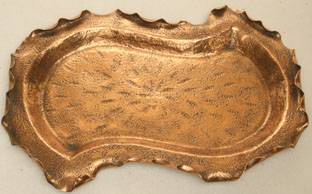
Trays of ‘Acanthus Gongs’ long lasting patterned 1894 registered design by Townshend of Birmingham.
The company developed a method for using good thin hard brass with a hammered ‘Acanthus’ pattern that toughened the brass still further.

The edges of the trays were attractively raised to help keep the trays rigid. The shapes of the trays were both decorative and functional.
They were given a lacquered finish that was hard enough to stand frequent use. As long as that finish is still intact the trays are easy to keep clean. If the lacquer is removed, the trays can be polished although some of the curves do present some problems.
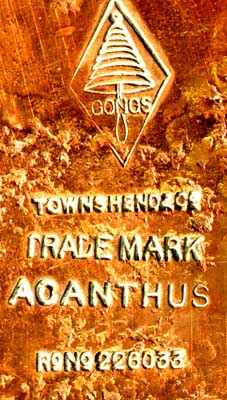 With this patterned brass and copper sheet they also made other items such as gongs, crumb trays, cake stands and fire screens. Rd No 226033 - 1894.
With this patterned brass and copper sheet they also made other items such as gongs, crumb trays, cake stands and fire screens. Rd No 226033 - 1894.
The Townshend name was used from about 1890 onwards, developed from previous makers. Their art metal market seems not to have recovered after the war and the firm switched production towards electrical fittings. Later they made metal shop display fittings.
6 A puzzling Monogram by Matthew J Hart & Co., c1890
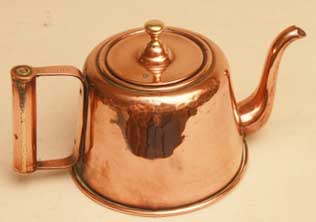
Stylish ‘Argyle’ kettle by Matthew J Hart & Co who were working in Birmingham around 1880-1900, making excellent domestic copperware such as teapots, jugs and hot water jugs. They used a monogram of their initials inside a heart in arts and crafts style which gave no clues as to their identity. This mark appeared on teapots with a handle mark of ‘Argyle’.
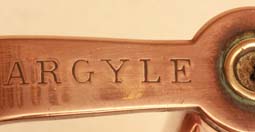
Was this from the Glasgow Hotel of that name that was a centre for the arts and crafts movement? Or was it labelled as an Argyle, meaning a serving vessel for gravy? Or was it just a model name given by the manufacturer?
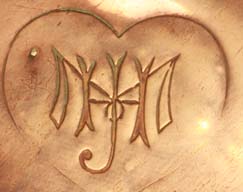
There was a Design Registration Number of 150094 under the Argyle teapots. A search at the National Archives for 1890 revealed the Matthew Hart maker’s name.
7 Quality Cast candlesticks from William Tonks & Sons, c1870
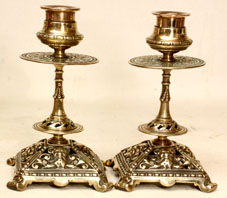 Excellent quality cast candlesticks, fingerplate, trivet or other product by William Tonks & Co of Birmingham with ‘WTS’ lettering in their smiling sun trademark. The quality of their foundry work is always excellent.
Excellent quality cast candlesticks, fingerplate, trivet or other product by William Tonks & Co of Birmingham with ‘WTS’ lettering in their smiling sun trademark. The quality of their foundry work is always excellent.
The Tonks name can be found as far back as 1789 and the company won gold medals for good quality art metalware at the Great Exhibition of 1851 and elsewhere.
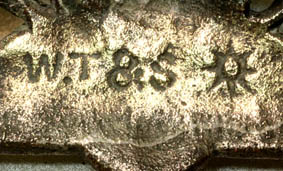
They developed a very large range of architectural brasswares with production rising through the late 19th and 20th centuries. They have undergone successive mergers through Newman-Tonks and now included in the Ingersoll-Rand Group.
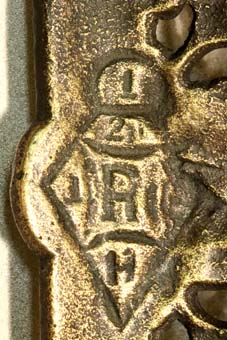
Diamond registration mark for 2nd April 1869
8 One of many Spirit Kettles by William Soutter & Sons c1910
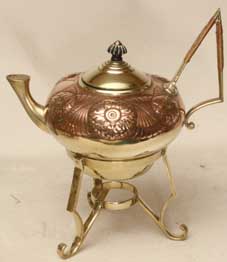 A well made spirit kettle on stand by William Soutter & Sons of Birmingham showing complex monogram. The company occupied a factory in Farm Street, Birmingham from 1907 until 1927. There they made a very large range of good quality holloware including jugs, kettles and sprit kettles on artistically designed stands, perhaps over 100 different products with few components in common.
A well made spirit kettle on stand by William Soutter & Sons of Birmingham showing complex monogram. The company occupied a factory in Farm Street, Birmingham from 1907 until 1927. There they made a very large range of good quality holloware including jugs, kettles and sprit kettles on artistically designed stands, perhaps over 100 different products with few components in common.
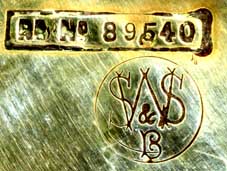 Their logo was a monogram of ‘SW&S over a ‘B’ (for Birmingham).
Their logo was a monogram of ‘SW&S over a ‘B’ (for Birmingham).
Some of the earlier logos with seriffed lettering over an ‘H’ (presumably for their address in Hockley, Birmingham). William Soutter & Sons ceased trading in 1927 and their site was thereafter occupied by a well known maker of industrial electric furnaces.
9 Rare Victorian Kettle by William Soutter & Sons c1850-1890
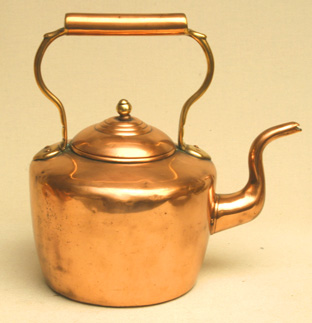 This is a classic hand made copper kettle of a type in use for centuries. The body is wrapped round, jointed and brazed and turned under for the base to be jointed and brazed in place. The spout is riveted in place to give strength before soldering, the lid has a typical turned brass knop, the handle supports are cast brass and the handle itself of copper.
This is a classic hand made copper kettle of a type in use for centuries. The body is wrapped round, jointed and brazed and turned under for the base to be jointed and brazed in place. The spout is riveted in place to give strength before soldering, the lid has a typical turned brass knop, the handle supports are cast brass and the handle itself of copper.
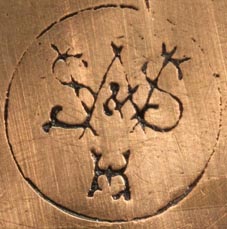 Underneath can be seen the monogram of William Soutter & Son with the very rare ‘H’ underneath (for Hockley) instead of the usual ‘B’ for Birmingham. The kettle was coated with ‘Incralac’ lacquer about ten years ago and is still untarnished.
Underneath can be seen the monogram of William Soutter & Son with the very rare ‘H’ underneath (for Hockley) instead of the usual ‘B’ for Birmingham. The kettle was coated with ‘Incralac’ lacquer about ten years ago and is still untarnished.
10 Victorian Kettle with a History
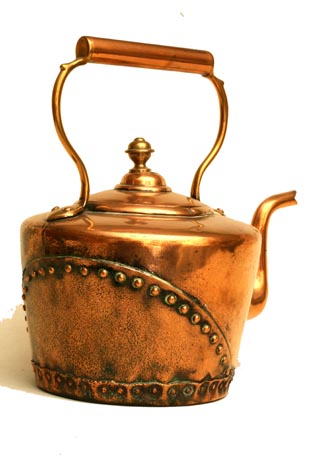 This kettle is similar to the Soutter example but slightly larger. It has really seen life! There are two very visible repairs that have resulted from being left over a hot fire and allowed to boil dry. A large copper patch has been riveted and soldered on the back with round headed rivets which means it was done by a boilersmith, not a coppersmith who would have used countersunk rivets.
This kettle is similar to the Soutter example but slightly larger. It has really seen life! There are two very visible repairs that have resulted from being left over a hot fire and allowed to boil dry. A large copper patch has been riveted and soldered on the back with round headed rivets which means it was done by a boilersmith, not a coppersmith who would have used countersunk rivets.
The second repair has needed a complete new bottom which has been hammered to shape, riveted and soldered in place to extend the life of the kettle again, showing how much value was placed on this simple copper kitchenware. Through all this the spout seems to have stayed correctly in place where one not so well fitted would have dropped out when the solder melted.
11 ‘Kinco’ items made by British Metal (Kingston) Ltd
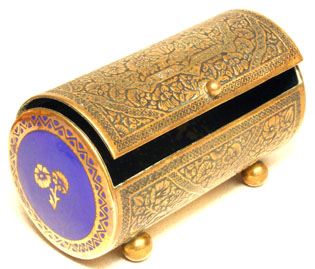 The ‘Kinco’ trade name can be found under many items of good quality brassware that has been deeply etched with decorative patterns and then filled with colour.
The ‘Kinco’ trade name can be found under many items of good quality brassware that has been deeply etched with decorative patterns and then filled with colour.
The patterns may be closely inspired by Indian, Chinese or Japanese themes after the visits of the Directors to those areas.
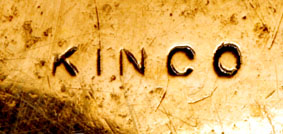 They also made many items with British themes including a 1935 ashtray specially made for the jubilee of King George the Fifth. They were in the art metalware business mainly from about 1923 until 1939 when they switched to making etched nameplates for the war effort.
They also made many items with British themes including a 1935 ashtray specially made for the jubilee of King George the Fifth. They were in the art metalware business mainly from about 1923 until 1939 when they switched to making etched nameplates for the war effort.
 Who made these items? A search of trade names showed that ‘Kinco’ was now registered in Britain to Harris Lifting Co and elsewhere to a maker of protective gloves, which was no help.
Who made these items? A search of trade names showed that ‘Kinco’ was now registered in Britain to Harris Lifting Co and elsewhere to a maker of protective gloves, which was no help.
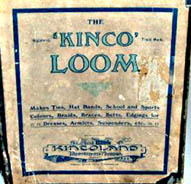
Only when the Kinco name was found on a model loom in original box together with the name and address of the company was the mystery solved. The factory was not sited in Birmingham like so many others but in Kingston-on-Thames, a suburb of London!
Vin's Ambitions
With the help of enthusiasts, to find the identity of some of the many unknown marks listed – such as ‘GWG’.
To find more marks from the 3,000 or so firms that made brassware in Birmingham.
After